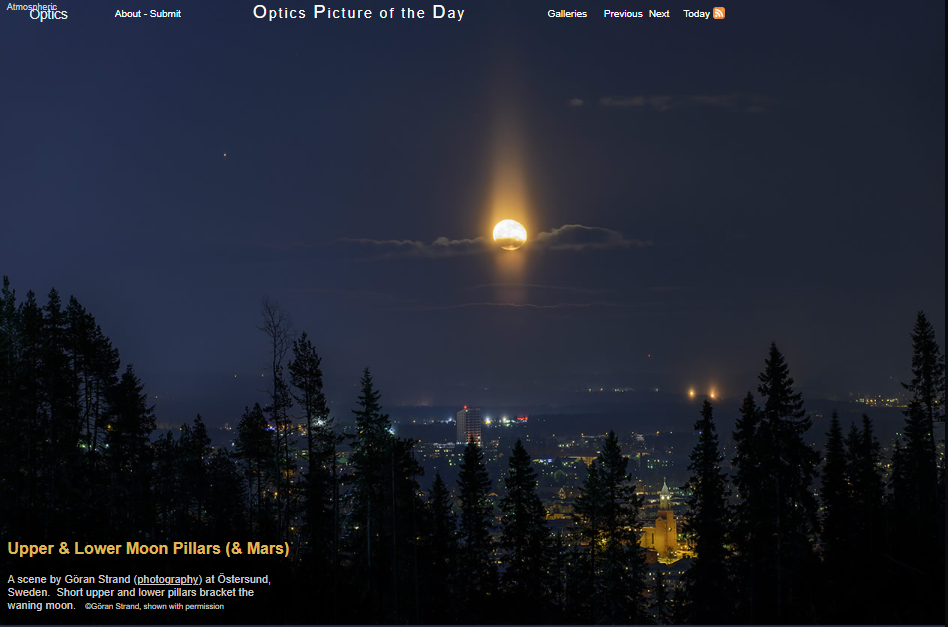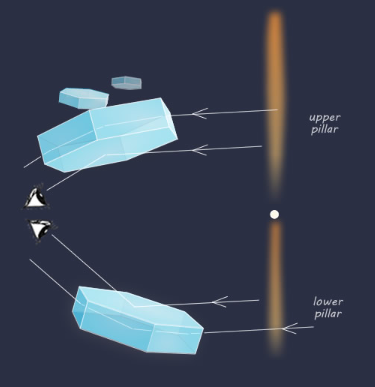Upper & Lower Moon Pillars - OPOD
Upper & Lower Moon Pillars - A Fascinating Atmospheric Phenomenon
When we gaze up at the night sky, we are often captivated by the beauty and mystery it holds. One such captivating phenomenon is the occurrence of upper and lower moon pillars. These ethereal pillars, sometimes accompanied by Mars, add a touch of magic to the already enchanting moon. In this article, we will delve deeper into the intriguing world of upper and lower moon pillars and explore the science behind their formation.
Unusual Sight: Observing Both Pillars
Spotting both upper and lower moon pillars simultaneously is an uncommon sight. The lower pillar specifically requires the moon or sun to be positioned at some height above the horizon. As the light source climbs higher, the pillars gradually become fainter. It is during moments when the sun or moon is at or just below the horizon that we witness the brightest and longest pillars. To increase your chances of observing lower pillars, venture to ski slopes when diamond dust fills the air, creating an ideal setting for these captivating phenomena.
Reflections from Ice Crystals: The Key to Pillar Formation
The mesmerizing pillars are formed due to reflections, both external and internal, from ice crystals suspended in the atmosphere. The crystals responsible for pillar formation tend to be large, imperfect, and most importantly, wobbly. Their imperfections contribute to the unique characteristics of these pillars.
Unveiling the Pillar Illusion: A Scientific Insight
In 1972, Robert Greenler and his team pioneered precise computer ray tracing calculations that shed light on the mystery behind the pillar illusion. Surprisingly, their findings revealed that a sky filled with plate crystals, wobbling a few degrees from horizontal, could reflect sunlight and create two elongated halos that appear to stretch upwards and downwards. Interestingly, the distance of the crystals from the observer is immaterial in creating this illusion. Whether the crystals are a few feet away or many miles, the pillars will still appear at infinity.
The Beauty of Imperfection: Wobbly Crystals and Pillar Formation
The wobbling motion of the ice crystals plays a crucial role in pillar formation. While perfect and regular crystals may seem visually appealing, they do not possess the necessary qualities to generate pillars. It is the imperfections and wobbliness of the crystals that contribute to the enchanting nature of these atmospheric phenomena.
Exploring Further: Diamond Dust and Lower Pillars
If you wish to witness lower pillars and their close relative, subsuns, a visit to ski slopes during diamond dust events is highly recommended. Diamond dust refers to tiny ice crystals that float in the air, creating a sparkling effect reminiscent of diamonds. When diamond dust throngs the air, it provides an ideal environment for the formation of lower pillars, adding an extra layer of fascination to the wintry landscape.
Conclusion
Upper and lower moon pillars are truly captivating atmospheric phenomena that add a touch of wonder to our night skies. Through the reflection of light from wobbly ice crystals, these pillars create a visual spectacle that enchants observers around the world. While their occurrence may be rare, their beauty and scientific significance continue to inspire awe and curiosity. So, the next time you find yourself gazing at the moon, keep an eye out for these magical pillars and marvel at the intricacies of our ever-fascinating atmosphere.

Upper & Lower Moon Pillars (& Mars)
A scene by Göran Strand (photography) at Östersund, Sweden. Short upper and lower pillars bracket the waning moon. ©Göran Strand, shown with permission
To see both pillars is unusual, the lower pillar requires the moon or sun to be at some height above the horizon. But pillars get fainter and fainter as the light source climbs. The brightest and longest pillars are usually when the sun or moon is at the horizon or just below it. Alternatively, for lower pillars and their close relation subsuns, go to ski slopes when diamond dust throngs the air.

Reflections � both external and internal � from ice crystals generate pillars. Those at right are too perfect and too regular. Pillar crystals tend to be large, imperfect and most important of all � wobbly.
Precise computer ray tracing calculations pioneered by Robert Greenler et. al. in 1972 showed that � perhaps surprisingly � a sky full of plate crystals wobbling a few degrees from horizontal would reflect sunlight to form two elongated halos apparently stretching upwards and downwards. The distance of the crystals is immaterial and the 'pillars' are at infinity. The pillar illusion hold whether crystals are a few feet away or many miles.
Note: this article has been automatically converted from the old site and may not appear as intended. You can find the original article here.
Reference Atmospheric Optics
If you use any of the definitions, information, or data presented on Atmospheric Optics, please copy the link or reference below to properly credit us as the reference source. Thank you!
-
<a href="https://atoptics.co.uk/blog/upper-lower-moon-pillars-opod/">Upper & Lower Moon Pillars - OPOD</a>
-
"Upper & Lower Moon Pillars - OPOD". Atmospheric Optics. Accessed on November 21, 2024. https://atoptics.co.uk/blog/upper-lower-moon-pillars-opod/.
-
"Upper & Lower Moon Pillars - OPOD". Atmospheric Optics, https://atoptics.co.uk/blog/upper-lower-moon-pillars-opod/. Accessed 21 November, 2024
-
Upper & Lower Moon Pillars - OPOD. Atmospheric Optics. Retrieved from https://atoptics.co.uk/blog/upper-lower-moon-pillars-opod/.